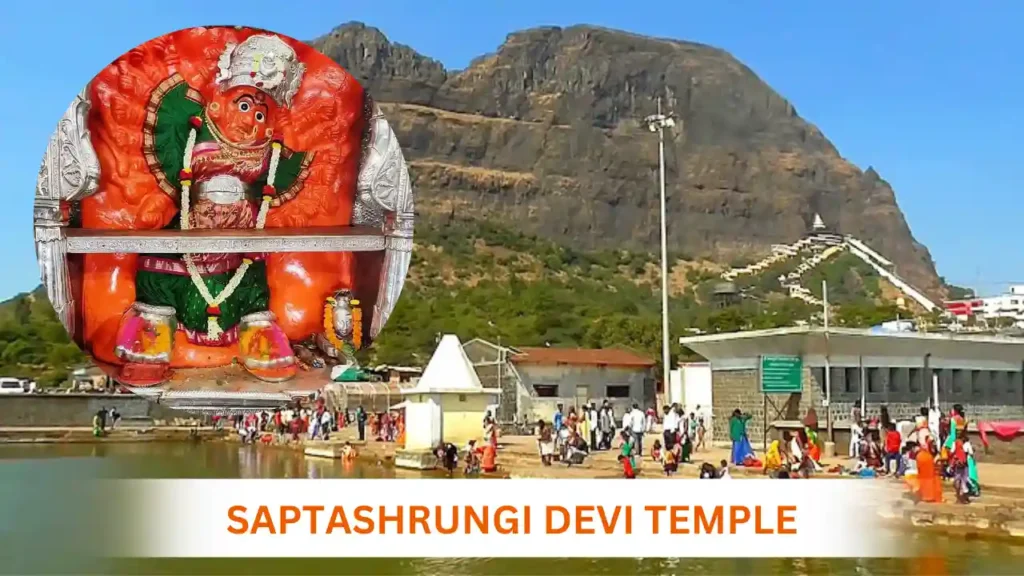Table of Contents
The Vani Saptashrungi Devi Temple, nestled in the serene hills of Nashik, Maharashtra, is a revered destination for pilgrims and nature enthusiasts alike. Known for its spiritual significance, breathtaking views, and rich history, this temple is dedicated to Goddess Saptashrungi, believed to be a form of Goddess Durga. The temple is not only a place of worship but also a significant cultural and historical landmark.
In this blog, we will delve into the history, significance, travel tips, and nearby attractions of the Vani Saptashrungi Devi Temple, while also exploring the mesmerizing regions of Trimbak and Nashik, which are integral to the spiritual and cultural fabric of Maharashtra.
The Spiritual Essence of Vani Saptashrungi Devi Temple
History and Mythology
The Saptashrungi Devi Temple derives its name from the seven mountain peaks (Sapta means seven and Shrungi means peaks) that surround it. According to Hindu mythology, Goddess Saptashrungi is one of the 51 Shakti Peethas, where parts of Goddess Sati fell after her immolation. It is believed that her right arm fell at this site, making it a revered Shakti Peetha.
Goddess Saptashrungi is depicted with 18 arms, each holding a weapon, symbolizing her power to protect her devotees and destroy evil. Legends narrate that she played a pivotal role in slaying demons and restoring balance in the universe.
Architectural Beauty
The temple is perched at an altitude of about 1,230 meters above sea level and offers panoramic views of the surrounding Sahyadri hills. The temple structure is a blend of traditional and modern architecture, with intricate carvings and vibrant idols that captivate visitors.
The climb to the temple involves a 510-step staircase, though a ropeway facility has been introduced for the convenience of devotees. The sanctum sanctorum houses the idol of Goddess Saptashrungi, adorned with ornaments and flowers, exuding an aura of divinity.
Nashik – The Gateway to Spirituality
An Overview of Nashik
Nashik, often referred to as the Wine Capital of India, is a city of immense spiritual and historical importance. Located on the banks of the Godavari River, Nashik is mentioned in ancient Hindu scriptures and is renowned for hosting the Kumbh Mela, one of the largest religious gatherings in the world.
Spiritual Landmarks
- Panchavati: This sacred area in Nashik is associated with the Ramayana, where Lord Rama, Sita, and Lakshmana spent part of their exile. Temples like Sita Gufa and Kalaram Temple are must-visit spots here.
- Trimbakeshwar Temple: Just 30 kilometers from Nashik, the Trimbakeshwar Temple is one of the twelve Jyotirlingas of Lord Shiva. The temple, known for its unique Shiva Lingam with three faces, is an architectural marvel and a hub of spiritual activities.
- Godavari River Ghats: The ghats along the Godavari River, such as Ramkund, are considered holy and attract pilgrims for rituals and ceremonies.
Trimbak – A Gem of Spirituality
About Trimbak
Located in close proximity to Nashik, Trimbak is a quaint town surrounded by lush greenery and rolling hills. It is best known for the Trimbakeshwar Temple and the origin of the Godavari River.
Trimbakeshwar Jyotirlinga
The Trimbakeshwar Temple is a masterpiece of Hemadpanthi architecture, built with black stone and featuring intricate sculptures. The temple is also associated with the Kumbh Mela, held every 12 years.
Other Attractions in Trimbak
- Brahmagiri Hills: Known as the source of the Godavari River, these hills are ideal for trekking and offer mesmerizing views of the landscape.
- Anjaneri Hills: Believed to be the birthplace of Lord Hanuman, these hills are another significant spiritual and trekking destination near Trimbak.
Things to Do at Vani Saptashrungi Devi Temple
Pilgrimage and Prayers
Offer your prayers to the Goddess and experience the divine energy of the temple. The annual Navratri festival is a grand celebration here, drawing thousands of devotees.
Trekking and Ropeway
For adventure enthusiasts, climbing the steps to the temple is a rewarding experience, offering stunning vistas of the Sahyadri hills. The ropeway provides a quicker and scenic journey to the temple.
Exploring the Surroundings
The lush green surroundings of the temple are perfect for nature walks and photography.
How to Reach Vani Saptashrungi Devi Temple
By Road
The temple is about 60 kilometers from Nashik, and the journey takes approximately 1.5 hours by car or bus. Roads are well-maintained, making the drive pleasant.
By Rail
The nearest railway station is Nashik Road Railway Station, located around 70 kilometers from the temple. Taxis and buses are available from the station.
By Air
The nearest airport is Nashik Airport, about 90 kilometers away. From there, one can hire a taxi or take a bus to the temple.
Best Time to Visit
The ideal time to visit the temple is between October and March, when the weather is pleasant. Visiting during Navratri adds a festive charm to your experience.
Tips for Visitors
- Wear comfortable clothing and footwear, especially if you plan to climb the steps.
- Carry water and snacks, but ensure you don’t litter.
- Respect the sanctity of the temple and follow the rules.
- Opt for early morning visits to avoid crowds.
Nearby Attractions
1. Anjaneri Hills
Located between Nashik and Trimbak, these hills are a haven for trekkers and history enthusiasts.
2. Someshwar Temple
A serene temple dedicated to Lord Shiva, situated on the banks of the Godavari River.
3. Coin Museum
Located in Anjaneri, this museum showcases a fascinating collection of coins and artifacts from ancient India.
Conclusion
The Vani Saptashrungi Devi Temple, with its spiritual significance and natural beauty, is a must-visit destination for those seeking inner peace and a connection with nature. Coupled with the rich heritage of Nashik and the tranquility of Trimbak, this region offers a perfect blend of spirituality, history, and adventure.
Whether you are a pilgrim, a history buff, or a nature lover, the journey to Saptashrungi Devi Temple will leave an indelible mark on your soul. Plan your visit to this enchanting destination and immerse yourself in the divine aura of the Sahyadri hills.

